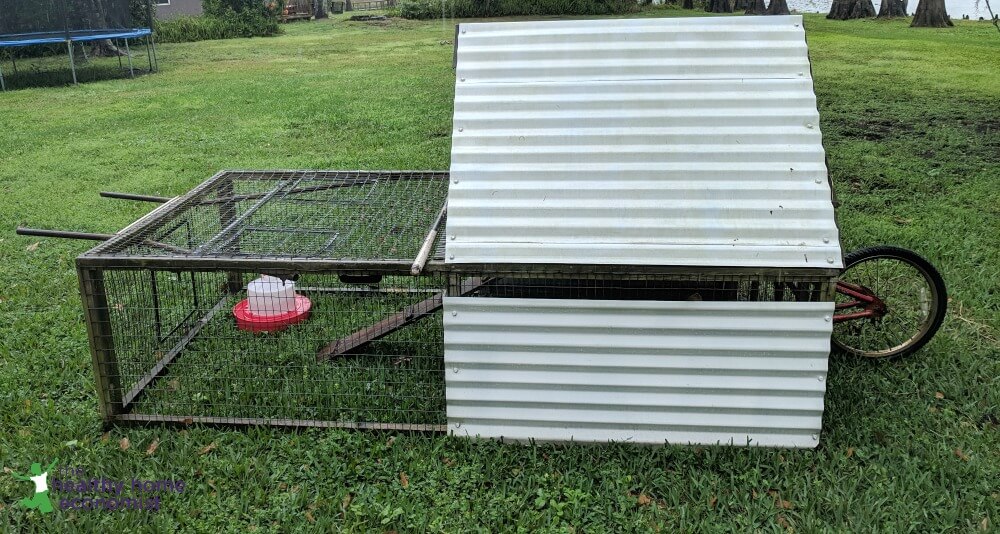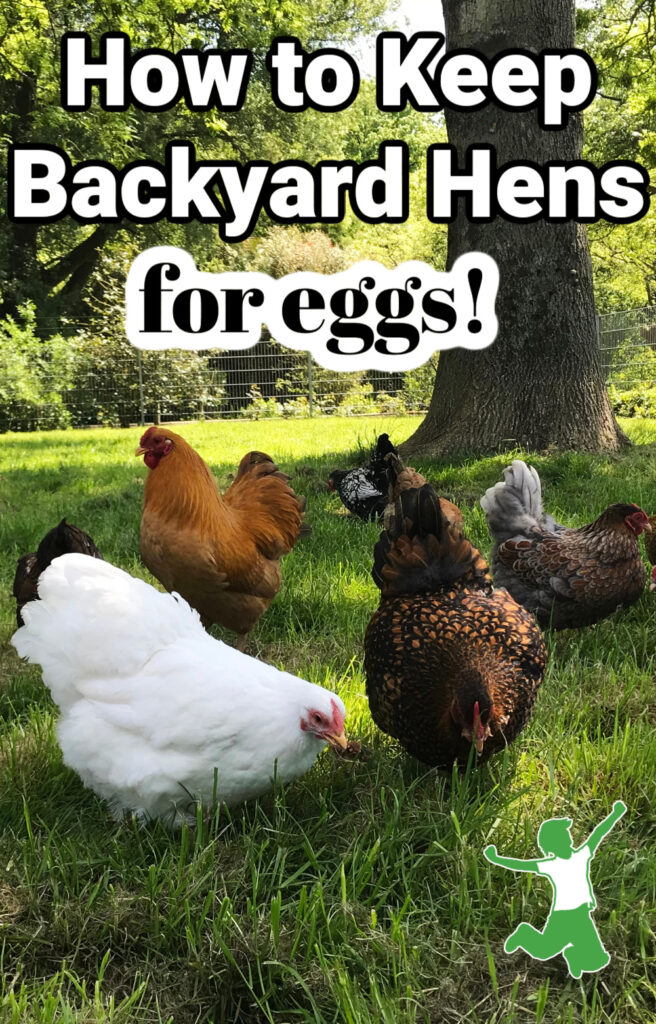Top 6 tips for successfully raising and keeping backyard chickens that will provide your family with excellent quality eggs and a whole lot of fun!

Not so long ago, the United States government actually advocated for people to keep backyard chickens – two per family member.
The USDA took the lead on the push for families to own laying hens with the slogan “in times of peace, a profitable recreation, in time of war a patriotic duty”.
Posters prominently hung around communities proclaimed that:
Even the smallest back yard has room for a flock large enough to supply the house with eggs. The cost of maintaining such a flock is small. Table and kitchen waste provide much of the feed for the hens. They require little attention–only a few minutes a day. (1)
Enter the “Green Revolution” post World War II. This agricultural phase marked the beginnings of industrialized farms and monocropping with the advent of cheap supermarket eggs from abused battery chickens kept in overcrowded, inhumane conditions.
It only took a couple of decades, but soon most people had completely forgotten about the wisdom and FUN of raising a few hens in the backyard.
Add to this the rise of suburban living and strict homeowner association rules forbidding the keeping of hens and the backyard chicken almost went extinct.
Backyard Chickens are BACK!
The rise of blogs shortly after the turn of the millennia and social media a few years later began to reverse the trend – and quickly!
Photos and video of abused hens from industrialized farms – even those that are so-called free-range – began to circulate widely with many going ballistically viral. A growing number of disgusted and disillusioned consumers responded by taking matters into their own hands.
Three of the major trends from this reversal of industrialized farming fortune include:
- Sourcing food locally as much as possible
- The revival of community-based farms and home gardens
- Keeping animals for meat, eggs, or dairy on the homestead
By far the most popular animal for urban homesteaders is the egg-laying hen. In my small neighborhood, almost a dozen homes have egg-laying hens in the backyard! This is up from just three a couple of years ago.
I am in my seventh year of keeping hens for eggs, and I can tell you — I’ve learned a lot during that time even though I believed that I was quite knowledgeable starting out.
One of the important things I’ve learned is how to get the most quality eggs from your laying hens!
Experience is a much more effective teacher than intellectual understanding alone, don’t you think?
With that, let me share with you the top 6 things I’ve learned about successfully keeping a small flock of egg-laying hens. If you’ve been thinking of taking the plunge, perhaps these tips will give you a little shove to get started!
You Don’t Need a Rooster
My first tip to share about keeping backyard chickens is that you absolutely DO NOT need a rooster.
This comes as a surprise to many people I’ve talked to who believe that hens won’t lay eggs unless there is a rooster around.
Not true!
Hens lay eggs like clockwork with or without a crowing rooster that wakes up the neighborhood.
Other myths unsupported by research are that fertilized eggs are more nutritious or that the egg whites from fertilized eggs don’t need to be cooked to be digestible.
I’ve yet to find a single credible source that either of these are true.
Unfertilized chicken eggs are just as tasty and delicious.
Unless you want to raise baby chicks as a business or have a serious problem with hawks, there is little reason to have a rooster.
In fact, I would argue that hens lay better without a rooster around.
First, they seem less likely to become broody (sitting on eggs for excessively long periods of time without food or water).
Secondly, a backyard sans Mr. Rooster is a decidedly less stressful environment for hens to live.
Note that many local ordinances that forbid roosters still allow hens. Check yours and see! Even if you live in an urban or suburban location, keeping a few backyard hens is likely to be totally legal!
Mobile Chicken Coops
Joel Salatin of Polyface Farm is the first farmer to popularize mobile chicken coops. You can also build a DIY chicken coop inexpensively if you only have a few chickens.
If you go mobile, this means that your coop is on wheels or at least draggable to different locations in your yard.
This is awesome for several reasons.
First, a mobile coop confuses predators big time – especially foxes. It breaks up the routine so that the chickens are coming and going from a different spot every so often.
Secondly, it keeps your yard from being destroyed. See how nice my backyard grass is in the photo above even though I have 5 chickens roaming around it every day.
If you keep the chicken coop in one spot all the time, the floor of the coop will be dirt in short order. By moving the coop around, you can keep it on fresh grass as often as you like.
Third, mobile coops stay much cleaner because the birds aren’t walking around or sitting on droppings.
Chicken feet that stay clean translates into a more hygienic laying environment and ultimately, clean eggs that don’t need washing (and thus refrigerating).
If your coop isn’t mobile, it is fairly straightforward to add this feature.
As you can see from my mobile coop below, a bike wheel at the back and handlebars at the front make moving it around a breeze.

ACV in Drinking Water is a MUST
Chickens, like most birds, are rather fragile creatures compared to mammals. When they get sick, the chance of them dying is quite high especially if you don’t take action immediately (this recipe for feeding a sick chicken is my go-to under the weather hen chow).
That said, it is best to keep backyard hens well and avoid illness as much as possible.
My best tip for accomplishing this is to be vigilant in providing fresh water every day (or every other day at most) with added raw apple cider vinegar (packaged in glass only as vinegar leaches toxins from plastic).
Adding raw ACV to the water (1 tablespoon per gallon) provides probiotics and enzymes to the hens on a daily basis. It also helps keep their digestive system at the proper pH so that common problems like sour crop don’t occur.
Invest in Quality Motion Lights
You will quickly learn that protecting your backyard chickens from predators is job number one. All kinds of critters come out of the woodwork when chickens are in the area – especially if you let them free range during the day like I do.
Here are the predators in my community all of whom would gladly eat a chicken if given the chance.
- Fox
- Alligator
- Possum
- Raccoon
- Hawk
- Bobcat
- Coyote
Believe it or not, I’ve only lost one chicken in 7 years to one of these potential predators (bobcat).
Motion lights that turn on whenever there is movement around the chicken coop at dusk, dawn and nighttime is the biggest reason why. Light is very scary to a predator. In my experience, motion lights will almost always prevent an attack on your chickens before it even happens.
Inexpensive, Durable Fencing
Even if you have a spacious tract of land, you will want some sort of fencing to keep your chickens in areas that are safe for daytime free-ranging.
It also keeps your chickens from venturing into a neighbor’s yard.
If you have a serious problem with predators or the hens will potentially be outside at night, then an electrifiable mobile fence is a must.
Otherwise, you can use this same model as a non-electrified mobile fence if you bring your chickens into the coop promptly before dusk like I do.
It takes only a few minutes to set up, no special equipment is needed, and it can be moved around the yard and/or set up along property lines as needed.
Roosting Bar
Chickens ideally should roost above the ground at night. They are much safer this way (being off the ground reduces the risks of predators).
Roosting instead of sitting on the ground or in a hen house also keeps them healthier in the long run as this is the natural position for chickens to sleep.
Beware, as most kits for chicken coops shockingly do not include one! I had to install a roosting bar in my chicken coop. You don’t need to buy a fancy one. I used a 2×2 piece of wood purchased for a few dollars at the local hardware store.
This feature is very important, so if you buy a chicken coop kit or purchase one pre-made, make sure it has one!
Do you have backyard chickens? If so, what tips do you have to share that have made the process easier and more successful for you?

Reference








Thank you for the wonderful tips! Can you please share more pics of your mobile coop? I would love to see the inside showing the roost and nest box set up.
Snakes can also be a problem…even with grown hens (through the years…I’ve lost several hens this way, but no roosters). The snake tries to swallow the hen (head first), then regurgitates the smothered hen when it gets to the part where the body is too big to swallow. Thus, you’ll find a dead hen with a compressed head and neck. Remedy: I use rat wire to construct my coop (NOT chicken wire ~ that snakes can fit through). Bird wire can also be placed over chicken wire…causing the snake to become tangled…though very difficult to remove the snake to relocate him. Also, to check to see if an egg is fresh…put it in water and if it floats, don’t eat it.
Very useful advice! Thanks!
Chickens love to devour ticks!
Here in the Pennsylvania woods, lowering the tick population is a MUST.
I love my backyard chickens! I did not know about acv in their water, however. Thank you for sharing that. I’m going to start doing that right away. So easy! Another thing I learned from a friend – if they stop laying or slow down too much, you can add hot sauce to the kitchen scraps you give them. For some reason this works like a charm every time. They start right back up.
Love the picture of your cart! I live in Hawaii; one of the islands that have wild chickens which when mixed in with roosters and laying hens you get problems, so the cart with complete containment is great. Wild chickens will not lay consistently and will go for the bushes and valleys to lay and multiply; half of which may be rooster chicks. So noisy! If roosters breed with laying domestics they are half wild and not consistent.
We have a different set of conditions here.
I’ll check out DIY carts since its hard to get ready made shipped to Hawaii.